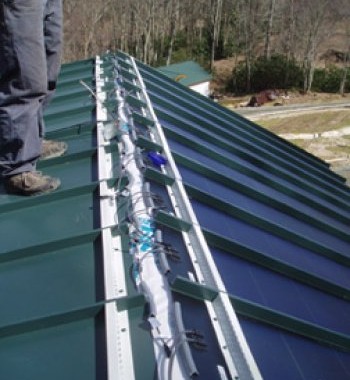For information about building or for a free initial office consultation contact Mountain Construction.
Story by Sam Calhoun
Photography by Nicholas Hurst
Reprinted from High Country Press, April 30, 2009
The same solar panels that were used on the Mir Space Station are now the core building blocks of an aesthetically pleasing solar power system on a private roof in Boone.
The panels--thin-film solar laminates that weigh less than one pound per square foot and produce 20 percent more energy than conventional panels--feed energy directly into the Blue Ridge Electric Membership Cooperative (BREMCO) grid and the homeowners receive cash and credits from BREMCO and NC GreenPower in return.
A Smart Choice--Financially Speaking
The setup plays out well for the homeowners and BREMCO. NC GreenPower pays the homeowners 15 cents per kilowatt-hour and BREMCO pays the homeowners 3 cents per kilowatt-hour for a total of 18 cents per kilowatt-hour for the solar energy produced. In turn, the homeowners buy all of their electricity from BREMCO for 9.6 cents per kilowatt-hour, leaving the homeowners with a credit of 8.4 cents. The homeowners receive a quarterly check for the difference from NC GreenPower and a monthly credit from BREMCO.
Based on current rates, the price of the system will be paid off in 11 years or less, at which time the homeowners will begin profiting in the clear. The homeowners don't have to worry about the system failing before it's paid off because it comes with a 20-year warranty.
In addition to the payback from BREMCO and NC GreenPower, the homeowners can deduct the entire price of the system from their taxes and take advantage of state and federal tax credits. What's more, the addition of the solar system to the BREMCO grid helps the cooperative meet its state-mandated goal of producing 10 percent of its energy from renewable sources by 2018.
A Smart Choice--Aesthetically Speaking
When the homeowners moved to Boone from Florida last year, they hired Mark Kirkpatrick of Mountain Construction Enterprises, Inc. to remodel a home off Russ Cornett Road in Boone. The homeowners knew they wanted green technologies integrated into the home during the remodel and toyed around with the idea of wind turbines. However, concerns over maintenance squashed their dreams of wind energy. Soon, though, Kirkpatrick presented the idea of using aesthetically pleasing Solar Seam roof panels on two south-facing portions of the homeowners' roof, and the homeowners agreed.
Kirkpatrick teamed with Solar Seam manufacturer Mike Roux of Construction Metal Products, Inc. out of Statesville, project manager Nick Hurst and installer Preston Reece of L&R Construction in Boone to complete the project.
One of Kirkpatrick's in-house construction crews started the remodel in October 2008, tearing off old siding and replacing it with new plywood and Hardie Plank, adding a small addition and tearing off the old roof.
Roux, Kirkpatrick, Hurst and Reece then went to work installing the Solar Seam roof. The Solar Seam is a standing seam metal roof that harvests energy from the sun using solar panels that are roughly as thin as a credit card. The panels are bendable, durable enough to walk on, low profile, resistant to dust and debris, have a stainless steel backing to prevent heat transfer, melt snow and ice and use three different wavelengths of light to absorb power--conventional panels only use one wavelength--meaning the Solar Seam panels produce 20 percent more power than conventional panels.
In manufacturing the Solar Seam, thin-film laminate is fused to the surface of the roofing panel substrate, or in this case a metal roof, with adhesive. The panel/laminate bond that is created has been tested and proven to withstand winds of 160 mph. The flexibility and durability of the laminate make it ideal for metal roofs, where expansion, contraction and curving are considerations. Unlike conventional panels, no roof penetrations and no additional structure support are required
Construction Metal Products, Inc. customizes solar roof systems for clients in its warehouse in Statesville so it can assure quality craftsmanship through building in a controlled environment. When customers order a Solar Seam system from the company, they receive a complete system, including wiring and electrical components. To create each system, Construction Metal Products, Inc. collects information from the homeowner, including the county where they live, width of roof, location and local power provider. Once the information is collected, the business plugs the variables into a spreadsheet and then creates a Return On Investment Report, or ROI, that lets the homeowner decide if the project is financially feasible. After completing an ROI for the house in Boone, Construction Metal Products, Inc. found that it would take just more than a decade for the homeowners to pay back their investment and start profiting.
Construction Metal Products, Inc. installed a metal roof on the house in Boone, adding standing metal seams every 16 inches to house the solar panels. The standing metal seams clip together, negating any need to nail into the roof. Twenty-four panels were used in total to complete the 1.5-kilowatt system. Each panel is 12 feet long and 16 inches wide and weighs less than traditional roofing shingles. At the top of each panel are two wire leads that connect along the roofs hidden ridgeline, funneling power to a DC cutoff switch and then into an AC/DC converter. Once converted into AC power, the energy is fed into the breaker box and then the BREMCO grid.
The homeowners chose to make their system a "buy all, sell all" arrangement where--as explained earlier--BREMCO buys all of their solar power and the homeowners purchase the energy to power their home from the cooperative. According to Brian Crutchfield, director of sustainable development for BREMCO, homeowners could also choose a "buy excess" system or a "net metering" system. A "buy excess" system allows a homeowner to use the solar energy produced at their home for personal use and then sell the excess to a local utility. A "net metering" system allows a home power meter to spin backward through renewable energy production and then the homeowner receives a credit on his/her monthly bill.
"You can get a good return on your investment with these systems," said Roux, who has installed similar systems in Florida and Hilton Head Island, SC.
"This is the first type of this kind of system in the High Country," added Crutchfield.
Mountain Construction does custom home building in any building style, including conventional new homes, remodeling and restorations, log and timber frame homes and structural insulated panel homes.


